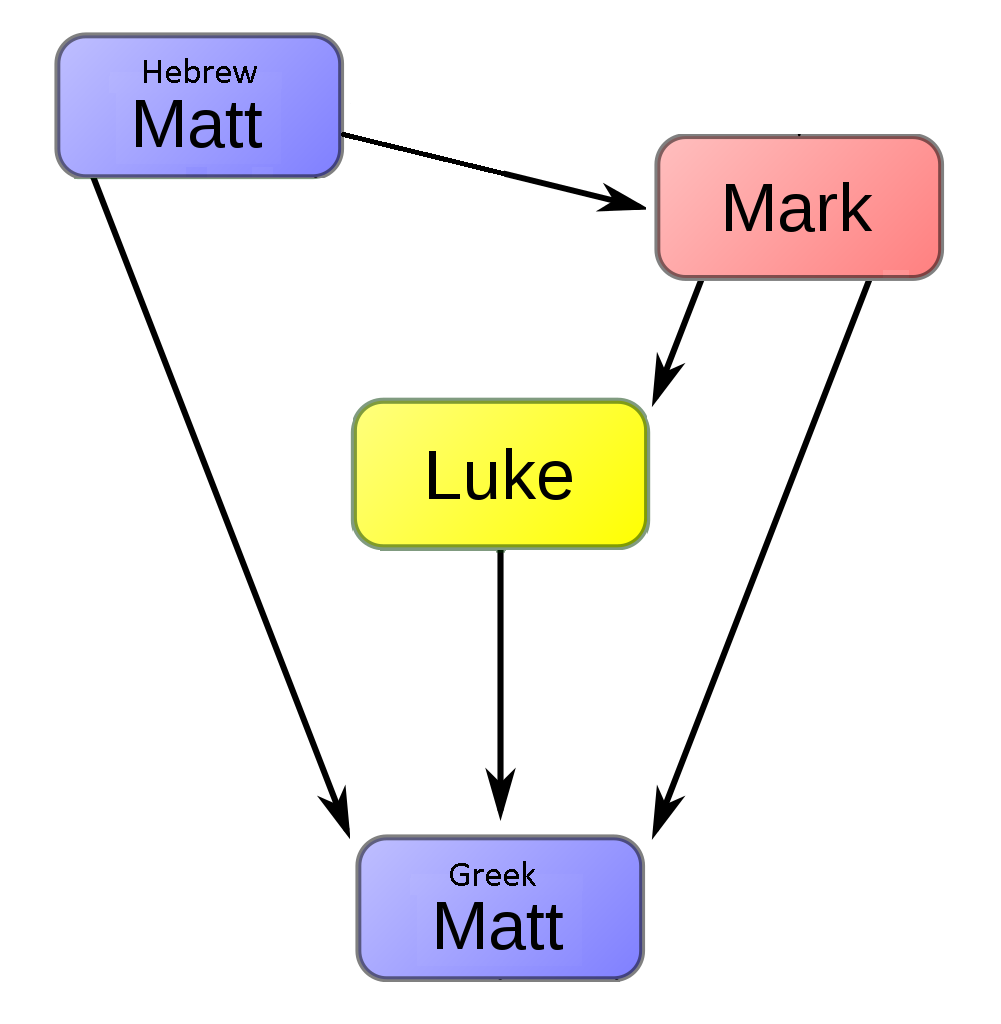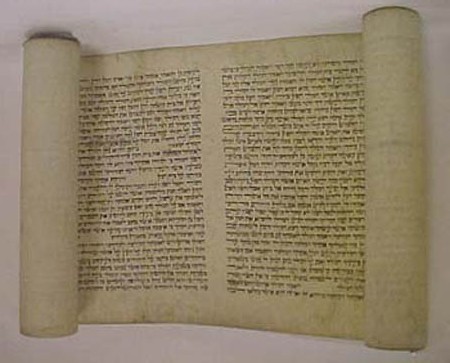|
M-Source
M source, which is sometimes referred to as M document, or simply M, comes from the M in "Matthean material". It is a hypothetical textual source for the Gospel of Matthew. M Source is defined as that 'special material' of the Gospel of Matthew that is neither Q source nor Mark. History Nineteenth century New Testament scholars who rejected the traditional perspective of the priority of Matthew in favor of Marcan priority speculated that the authors of Matthew and Luke drew the material they have in common with the Gospel of Mark from that Gospel. Matthew and Luke, however, also share large sections of text which are not found in Mark. They suggested that neither Gospel drew upon the other, but upon a ''second'' common source, termed the Q. This two-source hypothesis speculates that Matthew borrowed from both Mark and a hypothetical sayings collection, called Q. For most scholars, the Q collection accounts for what Matthew and Luke share – sometimes in exactly the s ... [...More Info...] [...Related Items...] OR: [Wikipedia] [Google] [Baidu] |
Two-source Hypothesis
The two-source hypothesis (or 2SH) is an explanation for the synoptic problem, the pattern of similarities and differences between the three Gospels of Matthew, Mark, and Luke. It posits that the Gospel of Matthew and the Gospel of Luke were based on the Gospel of Mark and a hypothetical sayings collection from the Christian oral tradition called Q. The two-source hypothesis emerged in the 19th century. B. H. Streeter definitively stated the case in 1924, adding that two other sources, referred to as M and L, lie behind the material in Matthew and Luke respectively. The strengths of the hypothesis are its explanatory power regarding the shared and non-shared material in the three gospels; its weaknesses lie in the exceptions to those patterns, and in the hypothetical nature of its proposed collection of Jesus-sayings. Later scholars have advanced numerous elaborations and variations on the basic hypothesis, and even completely alternative hypotheses that are increasing i ... [...More Info...] [...Related Items...] OR: [Wikipedia] [Google] [Baidu] |
Q Source
The Q source (also called The Sayings Gospel, Q Gospel, Q document(s), or Q; from , meaning "source") is a hypothesized written collection of primarily Jesus' sayings (, ). Q is part of the common material found in the Gospels of Matthew and Luke but not in the Gospel of Mark. According to this hypothesis, this material was drawn from the early Church's oral gospel traditions. Along with Marcan priority, Q had been hypothesized by 1900, and remains one of the foundations of most modern gospel scholarship. Funk, Robert W., Roy W. Hoover, and the Jesus Seminar. ''The Five Gospels.'' HarperSanFrancisco. 1993. "Introduction," pp. 1–30. B. H. Streeter formulated a widely accepted view of Q: that it was written in Koine Greek; that most of its contents appear in Matthew, in Luke, or in both; and that Luke better preserves the text's original order than does Matthew. In the two-source hypothesis, the three-source hypothesis and the Q+/Papias hypothesis, Matthew and Luke bot ... [...More Info...] [...Related Items...] OR: [Wikipedia] [Google] [Baidu] |
Aramaic Matthew
The Hebrew Gospel hypothesis (''proto-Gospel hypothesis'' or ''Aramaic Matthew hypothesis'') is that a lost gospel, written in Hebrew or Aramaic, predated the four canonical gospels. In the 18th and early 19th century several scholars suggested that a Hebrew proto-gospel (a so-called Ur-Gospel) was the main source or one of several sources for the canonical gospels. This theorizing would later give birth to the two source-hypothesis that views Q as a proto-gospel but believes this proto-gospel to have been written in Koine Greek. After the widespread scholarly acceptance of the two-source hypothesis, scholarly interest in the Hebrew gospel hypothesis dwindled. Modern variants of the Hebrew gospel hypothesis survive, but have not found favor with scholars as a whole. The foundation of the Hebrew gospel hypothesis is usually an early Christian tradition from the 2nd-century bishop Papias of Hierapolis. According to Papias, Matthew the Apostle was the first to compose a gospel, an ... [...More Info...] [...Related Items...] OR: [Wikipedia] [Google] [Baidu] |
Biblical Canon
A biblical canon is a set of texts (also called "books") which a particular Jewish or Christian religious community regards as part of the Bible. The English word ''canon'' comes from the Ancient Greek, Greek , meaning 'ruler, rule' or 'measuring stick'. The use of ''canon'' to refer to a set of religious scriptures was first used by David Ruhnken, in the 18th century. Various biblical canons have developed through debate and agreement on the part of the religious authorities of their respective faiths and denominations. Some books, such as the Jewish–Christian gospels, have been excluded from various canons altogether, but many Antilegomena, disputed books are considered to be biblical apocrypha or deuterocanonical by many, while some denominations may consider them fully canonical. Differences exist between the Hebrew Bible and Christian biblical canons, although the majority of manuscripts are shared in common. Different religious groups include different books in t ... [...More Info...] [...Related Items...] OR: [Wikipedia] [Google] [Baidu] |
Parable Of The Ten Virgins
The Parable of the Ten Virgins, also known as the Parable of the Wise and Foolish Virgins or the Parable of the Ten Bridesmaids, is one of the parables of Jesus. According to , ten virgins await a bridegroom; five have brought enough oil for their lamps for the wait, while the oil of the other five runs out. The five virgins who are prepared for the bridegroom's arrival are rewarded, while the five who went to buy further oil miss the bridegroom's arrival and are disowned. The parable has a clear eschatological theme: be prepared for the Day of Judgement. It was one of the most popular parables in the Middle Ages and had influence on Gothic art, sculpture and the architecture of German and French cathedrals. Narrative according to the Gospel of Matthew In the Parable of the Ten Virgins, Jesus tells a story about a party of virgins, perhaps bridesmaids or torchbearers for a procession, chosen to participate in a wedding. Each of the ten virgins is carrying a lamp or torch ... [...More Info...] [...Related Items...] OR: [Wikipedia] [Google] [Baidu] |
Eusebius
Eusebius of Caesarea (30 May AD 339), also known as Eusebius Pamphilius, was a historian of Christianity, exegete, and Christian polemicist from the Roman province of Syria Palaestina. In about AD 314 he became the bishop of Caesarea Maritima. Together with Pamphilus, Eusebius was a scholar of the biblical canon and is regarded as one of the most learned Christians during late antiquity. He wrote the ''Demonstrations of the Gospel'', '' Preparations for the Gospel'' and ''On Discrepancies between the Gospels'', studies of the biblical text. His work '' Onomasticon'' is an early geographical lexicon of places in the Holy Land mentioned in the Bible. As "Father of Church History" (not to be confused with the title of Church Father), he produced the ''Ecclesiastical History'', ''On the Life of Pamphilus'', the ''Chronicle'' and ''On the Martyrs''. He also produced a biographical work on Constantine the Great, the first Christian Roman emperor, who was ''Augustus'' between A ... [...More Info...] [...Related Items...] OR: [Wikipedia] [Google] [Baidu] |
Logia
The term ''logia'' (), plural of ''logion'' (), is used variously in ancient writings and modern scholarship in reference to communications of divine origin. In pagan contexts, the principal meaning was "oracles", while Jewish and Christian writings used ''logia'' in reference especially to " the divinely inspired Scriptures". A famous and much-debated occurrence of the term is in the account by Papias of Hierapolis on the origins of the canonical Gospels. Since the 19th century, New Testament scholarship has tended to reserve the term ''logion'' for a divine saying, especially one spoken by Jesus, in contrast to narrative, and to call a collection of such sayings, as exemplified by the Gospel of Thomas, ''logia''. Ancient use In pagan usage, ''logion'' was used interchangeably with ''chresmos'' (χρησμός) and other such terms in reference to oracles, the pronouncements of the gods obtained usually through divination. The Septuagint adapted the term ''logion'' to mean "Word ... [...More Info...] [...Related Items...] OR: [Wikipedia] [Google] [Baidu] |
German Language
German (, ) is a West Germanic language in the Indo-European language family, mainly spoken in Western Europe, Western and Central Europe. It is the majority and Official language, official (or co-official) language in Germany, Austria, Switzerland, and Liechtenstein. It is also an official language of Luxembourg, German-speaking Community of Belgium, Belgium and the Italian autonomous province of South Tyrol, as well as a recognized national language in Namibia. There are also notable German-speaking communities in other parts of Europe, including: Poland (Upper Silesia), the Czech Republic (North Bohemia), Denmark (South Jutland County, North Schleswig), Slovakia (Krahule), Germans of Romania, Romania, Hungary (Sopron), and France (European Collectivity of Alsace, Alsace). Overseas, sizeable communities of German-speakers are found in the Americas. German is one of the global language system, major languages of the world, with nearly 80 million native speakers and over 130 mi ... [...More Info...] [...Related Items...] OR: [Wikipedia] [Google] [Baidu] |
Jewish-Christian Gospels
Jewish Christians were the followers of a Jewish religious sect that emerged in Roman Judea during the late Second Temple period, under the Herodian tetrarchy (1st century AD). These Jews believed that Jesus was the prophesied Messiah and they continued their adherence to Jewish law. Jewish Christianity is the historical foundation of Early Christianity, which later developed into Nicene Christianity (which comprises the Roman Catholic, Eastern Orthodox, Oriental Orthodox, and Protestant traditions) and other Christian denominations. Christianity started with Jewish eschatological expectations, and it developed into the worship of Jesus as the result of his earthly ministry in Galilee and Jerusalem, his crucifixion, and the post-resurrection experiences of his followers. Jewish Christians drifted apart from Second Temple Judaism, and their form of Judaism eventually became a minority strand within mainstream Judaism, as it had almost disappeared by the 5th century AD ... [...More Info...] [...Related Items...] OR: [Wikipedia] [Google] [Baidu] |
Martin Hengel
Martin Hengel (14 December 1926 – 2 July 2009) was a German historian of religion, New Testament scholar, and Lutheran theologian, focusing on the Second Temple period and Hellenistic period of ancient Judaism and early Christianity. Early life Hengel was born in 1926 in Reutlingen, south of Stuttgart, at the time part of the Free People's State of Württemberg, Weimar Republic, and grew up in nearby Aalen. In 1943 he was conscripted as a 17-year-old schoolboy into the ''Wehrmacht'' and served in an anti-aircraft battery on the Western Front. In 1945, after one of the final battles of World War II, he threw away his weapons and uniform and walked home from France, completing his schooling in 1946.Obituary in '' |
Parable Of The Workers In The Vineyard
__NOTOC__ The Parable of the Workers in the Vineyard (also called the Parable of the Laborers in the Vineyard or the Parable of the Generous Employer) is a parables of Jesus, parable of Jesus which appears in matthew 20, chapter 20 of the Gospel of Matthew in the New Testament. It is not included in the other canonical gospels. It has been described as a difficult parable to #interpretation, interpret. Text Interpretations The parable has often been interpreted to mean that even those who are converted late in life earn equal rewards along with those converted early, and also that people who convert early in life need not feel jealous of those later converts. An alternative interpretation identifies the early laborers as Jews, some of whom resent the late-comers (Gentiles) being welcomed as equals in God's Kingdom. Both of these interpretations are discussed in Matthew Henry's 1706 Commentary on the Bible. An alternative interpretation is that all Christians can be identified w ... [...More Info...] [...Related Items...] OR: [Wikipedia] [Google] [Baidu] |




